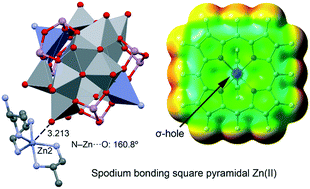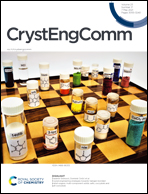Spodium bonding in five coordinated Zn(ii): a new player in crystal engineering?†
Abstract
This manuscript evidences the existence and importance of spodium bonds (SpB) in solid state structures involving five-coordinated square-pyramidal Zn(II) spodium atoms. Four families of compounds have been found analysing the Cambridge structural database (CSD) where the interaction is very important to understand the crystal packing: (i) multi-dentate Schiff-base complexes, (ii) Zn-porphyrins, (iii) aza-crown ethers and (iv) polyoxometalates, the latter as SpB acceptors. The square-pyramidal around the metal center facilitates the approximation of the electron rich atom (ElR) to the Zn(II), contrariwise to the four-coordinated tetrahedral geometry where the steric crowd of the Zn ligands usually impedes the formation of the SpB. This highlight concentrates on the SpB interaction, which is different from the classical coordination bond in the sense that Y–Sp⋯A distances are longer (around the sum of van der Waals radii), the interaction weaker and it involves the σ* orbital of the Y–Sp bond (Y = any atom). A theoretical study on one representative family of compounds (Zn-porphyrins) has been also carried out indicating that the SpB energies range from −1 to −7.4 kcal mol−1. Finally, a statistical analysis of the CSD evidences that the interaction can be somewhat directional.

- This article is part of the themed collections: 2021 Highlight article collection and Supramolecular & Polymorphism


 Please wait while we load your content...
Please wait while we load your content...